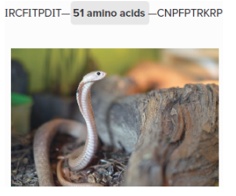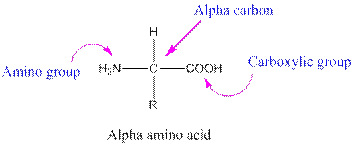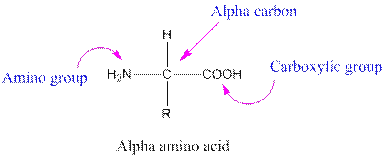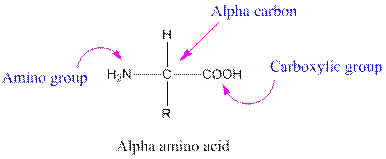
Concept explainers
a. How many amide bonds join the amino acids in the peptide chain?
b.Give the name of the N-terminal amino acid.
c.Give the name of the C-terminal amino acid. 
(a)
Interpretation:
The number of amide bonds that join the amino acids in the: IRCFITPDIT-51 amino acid-CNPFPTRKRP peptide chain.
Concept Introduction:
Amino acids are organic compounds containing two functional groups namely amino and carboxylic group. The amino group is attached to the alpha carbon, carbon adjacent to the carbonyl group making them alpha-amino acids.

Answer to Problem 38P
There are
Explanation of Solution
When amino acids joined to one another by amide bonds to form large molecules are called peptides. The amide bonds present in peptides are called peptides bonds.
To make a dipeptide, the amino group
To calculate the number of amide bonds present in any sequence will be one less the number of amino acids present in the sequence.
For example, there are two amino acids present in a dipeptide. Then, the number of amide bonds will be one.
The given sequence is as follows:
IRCFITPDIT-51 amino acid-CNPFPTRKRP
There are total
(b)
Interpretation:
The name of the N-terminal amino acid of the given amino acid sequence present in the bee venom should be determined.
IRCFITPDIT-51 amino acid-CNPFPTRKRP
Concept Introduction:
Amino acids are organic compounds containing two functional groups namely amino and carboxylic group. The amino group is attached to the alpha carbon, carbon adjacent to the carbonyl group making them alpha-amino acids.

Answer to Problem 38P
Isoleucine (I) will be the N-terminal amino acid present in the given sequence IRCFITPDIT-51amino acid-CNPFPTRKRP.
Explanation of Solution
Amino acid having a free
The name, one-letter and three-letter abbreviation of the amino acids are mentioned in the table given below:
| Name of Amino Acid | Three-letter abbreviation | One-letter abbreviation |
| Alanine | Ala | A |
| Asparagine | Asn | N |
| Cysteine | Cys | C |
| Glutamine | Gln | Q |
| Glycine | Gly | G |
| Isoleucine | Ile | I |
| Leucine | Leu | L |
| Methionine | Met | M |
| Phenylalanine | Phe | F |
| Proline | Pro | P |
| Serine | Ser | S |
| Threonine | Thr | T |
| Tryptophan | Trp | W |
| Tyrosine | Tyr | Y |
| Valine | Val | V |
| Aspartic acid | Asp | D |
| Glutamic acid | Glu | E |
| Arginine | Arg | R |
| Histidine | His | H |
| Lysine | Lys | K |
The given sequence is as follows:
IRCFITPDIT-51 amino acid-CNPFPTRKRP
From the table, 'I' will be the amino acid present at the N-terminal. And 'I' is the 'Isoleucine' amino acid.
(c)
Interpretation:
The name of the C-terminal amino acid of the given amino acid sequence present in the bee venom should be determined.
IRCFITPDIT-51 amino acid-CNPFPTRKRP
Concept Introduction:
Amino acids are organic compounds containing two functional groups namely amino and carboxylic group. The amino group is attached to the alpha carbon, carbon adjacent to the carbonyl group making them alpha-amino acids.

Answer to Problem 38P
Proline (P) will be the C-terminal amino acid present in the given sequence IRCFITPDIT-51amino acid-CNPFPTRKRP.
Explanation of Solution
Amino acid having a free
The name, one-letter and three-letter abbreviation of the amino acids are mentioned in the table given below:
| Name of Amino Acid | Three-letter abbreviation | One-letter abbreviation |
| Alanine | Ala | A |
| Asparagine | Asn | N |
| Cysteine | Cys | C |
| Glutamine | Gln | Q |
| Glycine | Gly | G |
| Isoleucine | Ile | I |
| Leucine | Leu | L |
| Methionine | Met | M |
| Phenylalanine | Phe | F |
| Proline | Pro | P |
| Serine | Ser | S |
| Threonine | Thr | T |
| Tryptophan | Trp | W |
| Tyrosine | Tyr | Y |
| Valine | Val | V |
| Aspartic acid | Asp | D |
| Glutamic acid | Glu | E |
| Arginine | Arg | R |
| Histidine | His | H |
| Lysine | Lys | K |
The given sequence is as follows:
IRCFITPDIT-51amino acid-CNPFPTRKRP
From the table, 'P' will be the amino acid present at the C-terminal. And 'P' is the 'Proline' amino acid.
Want to see more full solutions like this?
Chapter 21 Solutions
General, Organic, and Biological Chemistry - 4th edition
- 2. Please fill in missing reactants, reagents, reaction conditions, or products in the provided blank boxes OMe ...-CF2-CF2-CF2-CF2-CF2-...arrow_forwardDon't used hand raiting and don't used Ai solutionarrow_forwardI don't understand what to put for final step. Does that just mean termination? And would a radical form when I add bromine to ch2 between the rings?arrow_forward
- H2SO4 (cat.), H₂O 100 °C NH₂arrow_forwardX Draw the major products of the elimination reaction below. If elimination would not occur at a significant rate, check the box under the drawing area instead. ది www. Cl + OH Elimination will not occur at a significant rate. Click and drag to start drawing a structure.arrow_forwardNonearrow_forward
- 1A H 2A Li Be Use the References to access important values if needed for this question. 8A 3A 4A 5A 6A 7A He B C N O F Ne Na Mg 3B 4B 5B 6B 7B 8B-1B 2B Al Si P 1B 2B Al Si P S Cl Ar K Ca Sc Ti V Cr Mn Fe Co Ni Cu Zn Ga Ge As Se Br Kr Rb Sr Y Zr Nb Mo Tc Ru Rh Pd Ag Cd In Sn Sb Te I Xe * Cs Ba La Hf Ta W Re Os Ir Pt Au Hg Tl Pb Bi Po At Rn Fr Ra Ac Rf Ha ****** Ce Pr Nd Pm Sm Eu Gd Tb Dy Ho Er Tm Yb Lu Th Pa U Np Pu Am Cm Bk Cf Es Fm Md No Lr Analyze the following reaction by looking at the electron configurations given below each box. Put a number and a symbol in each box to show the number and kind of the corresponding atom or ion. Use the smallest integers possible. cation anion + + Shell 1: 2 Shell 2: 8 Shell 3: 1 Shell 1 : 2 Shell 2 : 6 Shell 1 : 2 Shell 2: 8 Shell 1: 2 Shell 2: 8arrow_forwardNonearrow_forwardIV. Show the detailed synthesis strategy for the following compounds. a. CH3CH2CH2CH2Br CH3CH2CCH2CH2CH3arrow_forward
 General, Organic, and Biological ChemistryChemistryISBN:9781285853918Author:H. Stephen StokerPublisher:Cengage Learning
General, Organic, and Biological ChemistryChemistryISBN:9781285853918Author:H. Stephen StokerPublisher:Cengage Learning Organic And Biological ChemistryChemistryISBN:9781305081079Author:STOKER, H. Stephen (howard Stephen)Publisher:Cengage Learning,
Organic And Biological ChemistryChemistryISBN:9781305081079Author:STOKER, H. Stephen (howard Stephen)Publisher:Cengage Learning, World of Chemistry, 3rd editionChemistryISBN:9781133109655Author:Steven S. Zumdahl, Susan L. Zumdahl, Donald J. DeCostePublisher:Brooks / Cole / Cengage Learning
World of Chemistry, 3rd editionChemistryISBN:9781133109655Author:Steven S. Zumdahl, Susan L. Zumdahl, Donald J. DeCostePublisher:Brooks / Cole / Cengage Learning Chemistry for Today: General, Organic, and Bioche...ChemistryISBN:9781305960060Author:Spencer L. Seager, Michael R. Slabaugh, Maren S. HansenPublisher:Cengage Learning
Chemistry for Today: General, Organic, and Bioche...ChemistryISBN:9781305960060Author:Spencer L. Seager, Michael R. Slabaugh, Maren S. HansenPublisher:Cengage Learning Introduction to General, Organic and BiochemistryChemistryISBN:9781285869759Author:Frederick A. Bettelheim, William H. Brown, Mary K. Campbell, Shawn O. Farrell, Omar TorresPublisher:Cengage Learning
Introduction to General, Organic and BiochemistryChemistryISBN:9781285869759Author:Frederick A. Bettelheim, William H. Brown, Mary K. Campbell, Shawn O. Farrell, Omar TorresPublisher:Cengage Learning Organic ChemistryChemistryISBN:9781305580350Author:William H. Brown, Brent L. Iverson, Eric Anslyn, Christopher S. FootePublisher:Cengage Learning
Organic ChemistryChemistryISBN:9781305580350Author:William H. Brown, Brent L. Iverson, Eric Anslyn, Christopher S. FootePublisher:Cengage Learning





